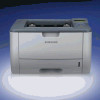Samsung ML-2855ND-TAA User Guide - Page 75
Common Windows problems, PROBLEM, POSSIBLE, CAUSE, SOLUTION, CONDITION, SUGGESTED SOLUTIONS - driver download
 |
UPC - 635753625585
View all Samsung ML-2855ND-TAA manuals
Add to My Manuals
Save this manual to your list of manuals |
Page 75 highlights
PROBLEM PostScript file cannot be printed. Limit Check Error report prints. A PostScript error page prints. The optional tray is not selected in the driver. POSSIBLE CAUSE The PostScript driver may not be installed correctly. The print job was too complex. The print job may not be PostScript. The printer driver has not been configured to recognize the optional tray. SOLUTION • Install the PostScript driver. (See "Installing USB connected machine's driver" on page 26, "Installing network connected machine's driver" on page 32.) • Print a configuration page and verify that the PS version is available for printing. • If the problem persists, contact a service representative. You might need to reduce the complexity of the page or install more memory. (See "Installing a memory module" on page 79.) Make sure that the print job is a PostScript job. Check to see whether the software application expected a setup or PostScript header file to be sent to the machine. Open the PostScript driver properties, select the Device Settings tab, and set the tray option of the Installable Options section to Installed. Common Windows problems CONDITION SUGGESTED SOLUTIONS "File in Use" message appears during installation. "General Protection Fault", "Exception OE", "Spool 32", or "Illegal Operation" messages appear. "Fail To Print", "A printer timeout error occurred" messages appear. Exit all software applications. Remove all software from the startup group, then restart Windows. Reinstall the printer driver. Close all other applications, reboot Windows and try printing again. These messages may appear during printing. Just keep waiting until the machine finishes printing. If the message appears in ready mode or after printing has been completed, check the connection and/or whether an error has occurred. Refer to Microsoft Windows 2000/XP/2003/Vista User's Guide that came with your computer for further information on Windows error messages. Common Linux problems CONDITION SUGGESTED SOLUTIONS The machine does not print. • Check if the printer driver is installed in your system. Open Unified Driver Configurator and switch to the Printers tab in Printers configuration window to look at the list of available machines. Make sure that your machine is displayed on the list. If not, open Add new printer wizard to set up your device. • Check if the machine is started. Open Printers configuration and select your machine on the printers list. Look at the description in the Selected printer pane. If its status contains Stopped string, press the Start button. After that normal operation of the machine should be restored. The "stopped" status might be activated when some problems in printing occurred. • Check if your application has special print option such as "-oraw". If "-oraw" is specified in the command line parameter, then remove it to print properly. For Gimp front-end, select "print" -> "Setup printer" and edit command line parameter in the command item. The machine does not print whole pages, and output is printed on half the page. It is a known problem that occurs when a color machine is used on version 8.51 or earlier of Ghostscript, 64-bit Linux OS, and has been reported to bugs.ghostscript.com as Ghostscript Bug 688252.The problem is solved in AFPL Ghostscript v. 8.52 or above. Download the latest version of AFPL Ghostscript from http://sourceforge.net/projects/ghostscript/ and install it to solve this problem. I encounter error "Cannot open port device file" when printing a document. Avoid changing print job parameters (via LPR GUI, for example) while a print job is in progress. Known versions of CUPS server break the print job whenever print options are changed and then try to restart the job from the beginning. Since Unified Linux Driver locks the port while printing, the abrupt termination of the driver keeps the port locked and unavailable for subsequent print jobs. If this situation occurs, try to release the port by selecting Release port in Port configuration window. Refer to Linux User's Guide that came with your computer for further information on Linux error messages. Troubleshooting_ 75















